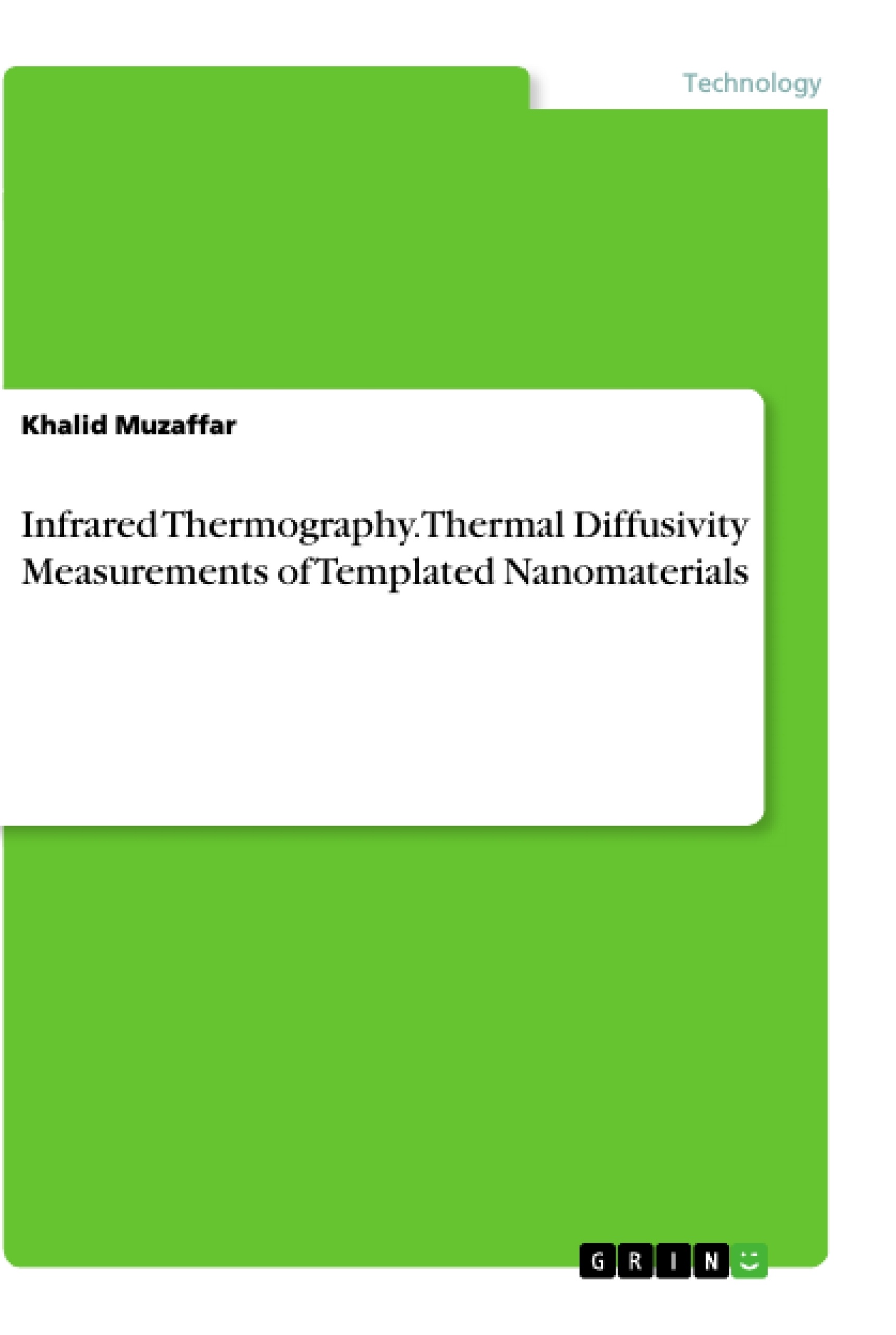This book documents the efforts towards thermal characterization of templated nanostructures using an infrared (IR) thermography based non-contact technique. One dimensional bismuth telluride Bi2Te3 nanostructures were grown using anodic alumina (AAO) template assisted electrodeposition technique. An infrared thermography based technique was then developed for the in-plane thermal diffusivity measurements of these templated nanocomposites. The thermal diffusivity of the nanowires alone was estimated through comparing the experimental results with the predictions made by a first order lower bound model (FOLBM). A mathematical background of the proposed technique with simulation studies is also reported.
Infrared thermography techniques are widely used for non destructive testing (NDT) and evaluation. The application areas are greatly varied: from water entrapment and moisture evaluation of buildings, degradation of EPROM (erasable programmable read only memory) chips and printed circuit boards, defect detection and characterization in turbine blades, medical and veterinary applications such as thermal coronary angiography, humane breast tumors, neuromuscular disorders, public services as forest fire detection and monitoring of traffic roads, to name a few.
Inhaltsverzeichnis (Table of Contents)
- Infrared thermography and nanomaterials: a review
- Introduction to infrared thermography.
- Infrared thermography in thermal characterization.
- Thermography at reduced dimensions...
- Anodic alumina (AAO) templated nanostructures.
- Thermoelectrics...
- Bismuth telluride (Bi2Te3) nanowires……
- Motivation and objectives of the thesis...
- Thesis overview.
- References......
- Synthesis and physical characterization of bismuth telluride nanowires
- Bi2Te3: one dimensional nanostructure..
- Electrodeposition of Bi2Te3 nanowires.
- Electrolyte preparation
- Working electrode preparation
- Electrodeposition process
- Physical characterization
- X ray diffraction study (XRD)
- Energy dispersive X-ray study (EDX).
- Scanning electron microscopy (SEM).
- Transmission electron microscopy (TEM).
- Aging of Bi2Te3 nanowires
- Single crystal bulk Bi2Te3
- Conclusions
- References
- Modeling, analysis and simulation of thermal waves in template nanomaterials
- Introduction.
- AAO template thermal response.
- Periodic point source heating..
- Thermal diffusivity measurement.
- IR experiment with empty AAO template.
- Simulation studies.
- Electro-thermal mode….........
- thermo SIM: software for thermal simulation……………….
- Phase image and phase image slope
- Influence of convection and radiation effects..
- Experimental verification of convection effect.
- Conclusions...
- References
Zielsetzung und Themenschwerpunkte (Objectives and Key Themes)
This thesis investigates the thermal properties of templated nanostructures using infrared thermography. The primary objective is to develop an efficient and reliable technique for measuring the in-plane thermal diffusivity of one-dimensional nanomaterials. The research focuses on the characterization of bismuth telluride (Bi2Te3) nanowires synthesized using anodic alumina (AAO) templates.
- Development of an infrared thermography-based technique for measuring thermal diffusivity of nanowires.
- Synthesis and characterization of Bi2Te3 nanowires using AAO templates.
- Modeling and simulation of thermal wave propagation in nanomaterials.
- Comparison of the thermal diffusivity of nanowires with their bulk counterparts.
- Evaluation of the influence of convective losses on thermal diffusivity measurements.
Zusammenfassung der Kapitel (Chapter Summaries)
- Chapter 1: Infrared thermography and nanomaterials: a review provides an overview of infrared thermography techniques and their applications in thermal characterization, particularly at reduced dimensions. It discusses the use of anodic alumina (AAO) templates for the synthesis of nanostructures and the significance of thermoelectric materials, specifically bismuth telluride (Bi2Te3) nanowires. The chapter outlines the motivation and objectives of the thesis, highlighting its contribution to the field.
- Chapter 2: Synthesis and physical characterization of bismuth telluride nanowires details the electrodeposition process used to synthesize one-dimensional Bi2Te3 nanowires using AAO templates. The chapter presents a comprehensive analysis of the nanowire structure and properties through techniques such as X-ray diffraction, energy dispersive X-ray spectroscopy, scanning electron microscopy, and transmission electron microscopy. Additionally, it explores the aging effects of Bi2Te3 nanowires and discusses the characteristics of single-crystal bulk Bi2Te3 samples.
- Chapter 3: Modeling, analysis and simulation of thermal waves in template nanomaterials focuses on the theoretical background of the proposed thermal wave imaging technique. It examines the thermal response of AAO templates, investigates the concept of periodic point source heating, and elaborates on the methodology for thermal diffusivity measurement. The chapter also discusses simulation studies, including the development of a software tool for thermal simulation, and analyzes the influence of convective losses on the measurements.
Schlüsselwörter (Keywords)
This thesis examines the thermal properties of templated nanomaterials, specifically focusing on one-dimensional bismuth telluride (Bi2Te3) nanowires grown using anodic alumina (AAO) templates. The research utilizes infrared thermography, including lock-in thermography and frequency modulated thermal wave imaging (FMTWI), for in-plane thermal diffusivity measurements. Key themes include nanomaterials, thermal characterization, infrared thermography, Bi2Te3 nanowires, AAO templates, thermal diffusivity, and modeling and simulation.
- Quote paper
- Khalid Muzaffar (Author), 2014, Infrared Thermography. Thermal Diffusivity Measurements of Templated Nanomaterials, Munich, GRIN Verlag, https://www.grin.com/document/461825




